(2: 中国科学院大学, 北京 100049)
(2: University of Chinese Academy of Sciences, Beijing 100049, P.R.China)
干旱是全球发生最普遍且损失最严重的自然灾害之一,具有发生频率高、影响范围广、持续时间长等特点[1-3]. 在全球气候变暖背景下,干旱事件的发生频率和强度都在呈显著增加趋势,而且根据预测,未来将会有更多陆地区域出现极端干旱[4-5]. 我国地处东亚季风区,气候条件复杂,降水的时空变率大,特殊的气候变化特征与地理环境导致大范围干旱灾害频繁发生,对当地粮食安全和人民生产生活造成严重危害[6-7],已成为制约经济以及生态可持续发展的重要因素之一[8]. 研究发现,近年来我国北方干旱频发的同时,南方湿润区干旱事件也在不断增加[9-10],尤其是季节性干旱[11-12]和骤发性干旱[13]突出. 例如西南地区2009年秋季至2010年春季遭遇百年一遇的特大旱灾,致使2500万人生活用水困难,大量农作物歉收或绝收[14];2011年长江中下游地区春旱造成江河及湖泊水位异常降低,湖区生态环境恶化,威胁水生动植物的生存和繁衍,造成了严重的经济损失[15]. 因此,对南方湿润地区季节性干旱的研究也已引起国内外学者的广泛关注,这对深入认识气候变化和人类活动影响下的干旱变化规律、影响因素以及区域防旱抗旱减灾等都具有重要的科学意义.
根据研究对象或应用领域的不同,干旱可分为气象干旱、水文干旱、农业干旱以及社会经济干旱4种类型[16]. 干旱指数是识别区域干旱最常用的指标[17],它不仅可以量化干旱的强度、持续时间等特征,而且在干旱评价以及监测预警方面也具有重要作用. 常用的干旱指标包括Palmer干旱指数(PDSI)、标准化降水指数(SPI)、标准化降水蒸散指数(SPEI)以及标准化径流指数(SRI)等[18-20]. 国内外诸多学者也从不同角度基于不同的干旱指标进行研究,例如莫兴国等[21]采用PDSI评估了未来气候变化情景下我国干旱事件发生频次、强度和持续时间的可能变化;李明等[22]计算了不同时间尺度的SPI,结合游程理论识别中国东部季风区气象干旱事件. 由于变化环境下气象水文时间序列受到气候变化和人类活动的影响呈现非平稳特征[23],而传统干旱指数的计算很大程度上依赖平稳性假设[24],因此一些学者尝试构建非平稳干旱指数来识别干旱事件. 例如温庆志等[25]在SPEI和非平稳性理论基础上构建了非平稳性标准化降水蒸散指数,用来评估不同排放情景下中国气象干旱的时空格局;李敏等[26]通过GAMLSS模型构建时变SRI以评价流域变化环境下的水文干旱. 此外,干旱具有多个特征变量,基于单一变量的分析无法完全解释干旱各特征变量之间的关系,因此,越来越多的研究更注重基于多变量的联合分析. 其中,Copula函数能够通过边缘分布和相关性结构来构造多维联合分布[27],既能进行特征的联合,又可以进行区域联合,特别适用于多变量水文分析,已在极端降水、洪水频率分析和干旱特征分析等方面广泛应用[28-30]. 如陈永勤等[31]基于游程理论识别了鄱阳湖流域水文干旱特征变量,采用Copula函数分析了主要支流的干旱历时和干旱烈度的联合概率特征;Xu等[32]在考虑干旱事件时空变化基础上,构建了干旱持续时间、影响面积以及严重程度的三变量联合分布. Zhang等[33]利用河流径流和湖泊水位构建水文干旱指数对鄱阳湖、鄱阳湖流域和长江的联合水文干旱进行了研究. Copula函数已被证明是多元水文分析和模拟的有效工具.
洞庭湖是我国第二大淡水湖,也是三峡水库坝下第一个大型通江湖泊[34],素享“鱼米之乡”的美誉. 湖区接纳流域“四水”(湘江、资水、沅江、澧水)和长江“三口”(松滋口、太平口、藕池口)的径流,经湖泊调蓄后于城陵矶汇入长江,形成了复杂的江-湖-河水系格局[35]. 受气候变化与人类活动的影响,洞庭湖在过去几十年间多次发生不同程度的旱灾[36]. 尤其是2000年以来在流域径流变化及长江上游大型水利工程的共同影响下,江湖关系发生变化,水量平衡关系改变,湖泊干旱事件更为频繁,洞庭湖湖容明显减小,枯水期提前[37],季节性水文干旱不断加剧[38]. 目前有关洞庭湖干旱的研究多侧重于湖泊或流域干旱特征的描述以及三峡水库运行后江湖关系改变对洞庭湖水情变化的影响等方面,未将长江、洞庭湖及其流域作为一个系统考虑,也未揭示系统内洞庭湖干旱与流域、长江干流水文干旱的内在关联与相互作用关系. 因此,本文基于传统和时变标准化水位指数(SWI)和标准化径流指数(SRI),通过Copula函数分析洞庭湖-流域-长江系统1964-2016年水文干旱事件的联合概率分布特征,明确具有不同属性的水文干旱事件在洞庭湖-流域-长江系统的相关性,探讨洞庭湖水文干旱的成因及其对江湖关系变化的响应. 本研究对进一步认识洞庭湖干旱的发生机理具有重要意义,同时也为洞庭湖防旱抗旱减灾以及科学实施干旱预警提供重要的科学依据.
1 研究区域与方法 1.1 研究区域与数据资料洞庭湖(28°03′~30°20′N,111°40′~113°30′E)地处长江中游荆江河段以南,湖南省东北部,由西洞庭湖、南洞庭湖和东洞庭湖3个湖区组成,是国际重要的湿地保护区. 洞庭湖流域水系发达,流域面积约26万km2,占长江流域总面积的12 % [39]. 洞庭湖是我国典型的大型调蓄湖泊,长江径流由松滋、太平、藕池“三口”分流入湖,与流域“四水”在湖区汇合调蓄后又由唯一的通道城陵矶注入长江[40],流域与长江汇水以及长江的顶托作用共同决定了湖泊的水位. 洞庭湖流域与长江中游整体上属于亚热带湿润季风气候,四季分明,降水季节集中且年际变化大. 因此长江与流域入湖径流量的年内分配也不均匀,流域与长江的水情变化直接影响洞庭湖的水量变化,季节性降水导致洞庭湖具有明显的季节性水文特征. 通常流域汛期为4-6月,洞庭湖受流域补给在4月水位开始上升;长江汛期为7-9月,湖水位继续抬升至年内最高[41]. 流域与长江之间的汛期转换使洞庭湖成为一个复杂的江-湖-河系统.
本研究选取洞庭湖南咀、小河咀、城陵矶3个水文站1964-2016年水位数据,以3站平均水位反映洞庭湖的整体水位变化情况. 以洞庭湖流域桃江、桃源、湘潭水文站径流量代表流域入湖水量变化情况(图 1). 选取长江干流宜昌站径流量代表长江来水变化情况. 并且以2003年三峡大坝运行为时间断点,在总研究时段中重点关注2003年之后的水文干旱. 上述数据均来源于长江水利委员会水文局. 流域内同期降水数据来源于国家气象中心,主要用于水文干旱事件的成因分析.
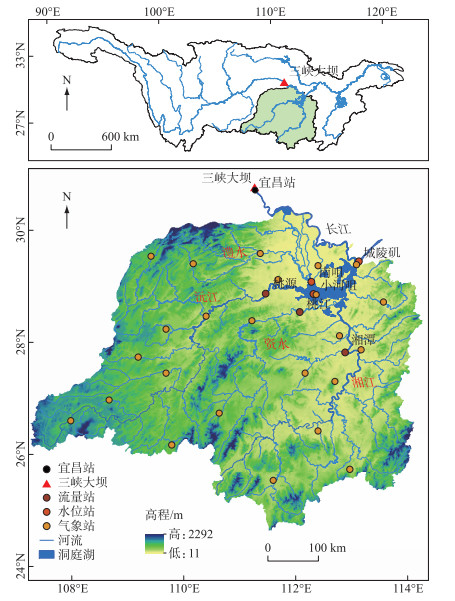
|
图 1 洞庭湖-流域-长江系统水系和水文站、气象站分布 Fig.1 Locations of river network, hydrological stations and meteorological stations in the Lake Dongting-catchment-Yangtze River system |
标准化水位指数SWI和标准化径流指数SRI是参照标准化降水指数SPI这一概念而提出,用于识别区域水文干旱和量化干旱等级[42],两者的计算过程与SPI类似. 考虑到长时间水位和径流序列可能存在非平稳特征,因此在干旱指数计算前首先进行MK趋势检验[43],趋势变化显著的季节则在GAMLSS框架下计算时变标准化水位指数和径流指数[26, 44-45]. 水文干旱根据SWI和SRI大小共划分为5个干旱等级[46](表 1),当SWI和SRI值低于-1时,即认为发生水文干旱,并且其数值越小,表明其干旱强度越大,本研究关注中度及以上程度的水文干旱(即SWI≤-1、SRI≤-1). 同时,为了反映洞庭湖-流域-长江系统水文干旱变化的总体特征,分别从年和季节时间尺度分析SWI与SRI的变化情况,其中选用12个月尺度下的SWI与SRI值代表年际变化,选用3个月尺度下5、8、11以及次年2月的值分别代表春、夏、秋、冬季变化.
| 表 1 水文干旱等级划分 Tab. 1 Classification of hydrological drought index |
建立联合分布函数之前首先需要确定每个水文干旱指标的边缘分布函数[30],水文科学领域存在多种随机变量分布函数,本文选择在干旱分析中广泛应用的Weibull、Logis和Gamma分布函数来研究SWI和SRI概率分布特征,并采用最大似然函数和线性矩法进行参数估计.
1.2.3 Copula函数Copula理论最初由Sklar[47]提出,目前已广泛应用于二元和多元干旱频率分析. Copula函数根据随机变量之间的依赖结构,连接一维边缘分布以形成概率区间在[0, 1]上的多元联合分布[48]. 在研究中常用的Copula函数分为4种类型:阿基米德型(Frank、Clayton、Gumbel),椭圆型(t、Gaussian),极值型(Husler-Reiss、t-EV)和混合型(Plackett)[32]. 本文采用Gumbel、Clayton、Frank、Gaussion、t和Plackett 6种Copula函数进行拟合,同时根据相关性指标法,建立起Kendall秩相关系数τ与Copula函数的参数θ之间的关系来进行参数估计[49].
根据Sklar定理,假设两个相关的水文事件X和Y分别具有FX(x)、FY(y)分布,则它们的联合分布F(x, y)如下:
| $ F(x, y)=P(X \leqslant x, Y \leqslant y)=C_{\theta}\left(F_{X}(x), F_{Y}(y)\right) $ | (1) |
式中,C表示变量X和Y的二元依赖结构的Copula函数,θ为待定参数. 在本研究中,X和Y指SWI和SRI的时间序列.
Kendall秩相关系数[50]计算公式如下:
| $ \tau=\frac{2}{n(n-1)} \sum\limits_{i=1}^{n-1} \sum\limits_{j=i+1}^{n} \operatorname{sgn}\left[\left(x_{i}-x_{j}\right)\left(y_{i}-y_{j}\right)\right] $ | (2) |
式中,τ为Kendall秩相关系数,xi, xj为对应时间段SWI和SRI的值,n为系列长度.
某一水文干旱事件的联合重现期[51]可由下式计算:
| $ T(X \leqslant x, Y \leqslant y)=\frac{s}{C\left(F_{X}(x), F_{Y}(y)\right)} $ | (3) |
式中,s是序列中出现的时间间隔. 当SWI和SRI时间尺度为12个月时,s=1年;当时间尺度为3个月时,s =0.25年.
在选择最优Copula函数之前,利用R语言软件包Copula对长江、洞庭湖及其流域水文干旱指数的可交换性进行检验[52],以获得统计量的近似P值,用来评估未知极值Copula C是否满足C(u,v)=C(v,u),u、v∈[0, 1]. 如果不拒绝可交换性检验,就可以排除不对称的Copula函数,从而减少Copula函数在拟合优选中的数量.
1.2.4 边缘分布函数和Copula函数的优选边缘分布函数通过Kolmogorov-Smirnov(K-S)检验法进行假设检验,达到95 % 置信水平则采用AIC信息准则[53]评价分布函数的拟合优度. 统计量D和AIC的值越小,表明函数拟合效果越好. Copula函数同样通过AIC信息准则进行拟合优度评价,最终从6种Copula函数中选择拟合最优的联合分布函数. 各检验方法的表达式如下:
| $D=\max _{i j}\left|F\left(X_{(i)}\right)-G\left(Y_{(j)}\right)\right| $ | (4) |
| $ MSE = \frac{1}{n}\sum\limits_{ij = 1}^n {{{\left[ {F\left( {{X_{(i)}}} \right) - G\left( {{Y_{(j)}}} \right)} \right]}^2}} $ | (5) |
| $ A I C=2 k+n \ln (M S E) $ | (6) |
式中,F(X)为经验分布函数,G(Y)为理论分布函数,MSE为均方误差;AIC为赤池信息准则,k为参数个数,n是样本个数.
2 结果分析 2.1 边缘分布函数和Copula函数的选择 2.1.1 边缘分布函数的选择基于Weibull、Logis和Gamma 3种边缘分布函数,分别对洞庭湖SWI、流域SRI以及长江SRI的分布进行拟合,K-S检验结果如表 2所示. 3种分布函数对不同时间尺度上SWI和SRI的拟合均通过了K-S检验. 根据统计量D与AIC最小值原则,选择拟合优度最高的分布函数作为不同区域各个季节水文干旱的边缘分布函数(表 3). 洞庭湖SWI在年尺度和夏季、秋季Logis函数对应的AIC值最小,遂选Logis函数为该时段的最优边缘分布函数. 在春季和冬季,Weibull与Gamma函数对应的AIC值最小,则Weibull与Gamma函数分别为春季和冬季的最优边缘分布函数;而对于流域SRI,在冬季最优边缘分布函数为Gamma,其他3个季节和年尺度均选择Weibull函数为最优边缘分布函数;长江SRI在年尺度和夏季最优边缘分布函数为Logis,在春季、秋季为Weibull函数,而在冬季为Gamma函数.
| 表 2 基于K-S检验的SWI和SRI边缘分布拟合优度值 Tab. 2 Goodness-of-fit values of the marginal distributions of the SWI and SRI based on the Kolmogorov-Smirnov test |
| 表 3 基于AIC信息准则的SWI和SRI边缘分布函数拟合优选* Tab. 3 Goodness-of-fit values of the marginal distributions of the SWI and SRI based on the AIC |
可交换性检验是基于经验Copula与潜在二元Copula可互换性的评估测试[54]. 表 4显示各联合水文干旱指标在95 % 置信水平下均通过交换性检验,意味着以上6种Copula函数可用于洞庭湖-流域-长江系统水文干旱联合概率的研究. 基于AIC最小值原则,从Gumbel、Clayton、Frank、Gaussion、t和Plackett Copula中选择拟合最优的Copula函数. 如表 5所示,洞庭湖-流域系统在年尺度和4个季节水文干旱联合概率拟合效果最优的Copula函数分别为Clayton、Frank、t、Gumbel和Gumbel;洞庭湖-长江系统则分别为t、t、Gaussion、Clayton和Clayton Copula.
| 表 4 SWI和SRI可交换性检验 Tab. 4 Exchange ability test of the SWI and SRI |
| 表 5 基于AIC选择Copula函数* Tab. 5 Select the Copula function based on AIC |
基于选定的不同区域最优边缘分布函数,分别分析洞庭湖、流域及长江的水文干旱概率分布特征(图 2). 在年尺度上,洞庭湖水文干旱的发生概率(SWI < -1)为14.01 %,重现期为7.14 a. 1964-2016年间,洞庭湖共发生9次水文干旱事件,其中4次出现在2003-2016年(表 6),最严重的水文干旱发生在2011年,SWI为-2.47(极端干旱). 流域水文干旱的发生概率为16.20 %,重现期为6.17 a,研究期内共识别出10次水文干旱事件,有2次发生在2003-2016年间,其中SRI最小值-2.55(极端干旱)也出现在2011年. 对于长江干流,1964-2016年水文干旱的发生概率为14.35 %,重现期6.97 a,过去53年间共发生7次水文干旱事件,其中2003年之后有3次,SRI最小值-3.39(极端干旱)发生在2006年. 从3个区域对比来看,虽然整体上流域发生水文干旱的概率最高,但2003-2016年间发生水文干旱的频次较少,而洞庭湖及长江在2003年以后发生水文干旱的频次明显增多,表明在2003年以后洞庭湖及长江水文干旱呈加剧态势,且二者的加剧态势具有同步性.
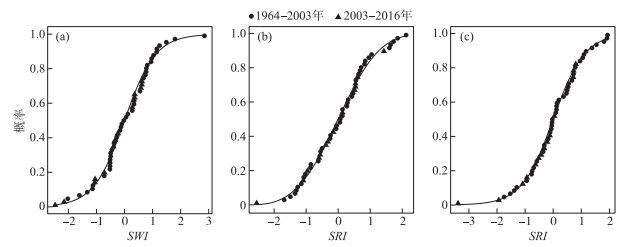
|
图 2 年尺度洞庭湖SWI概率分布(a);流域SRI概率分布(b);长江SRI概率分布(c) Fig.2 Annual scale probability distribution of the SWI of Lake Dongting(a); the probabilities of the SRI of the catchment(b) and Yangtze River(c) |
| 表 6 1964-2016年洞庭湖-流域-长江系统水文干旱概率对比 Tab. 6 Hydrological drought probability comparison of Lake Dongting-catchment-Yangtze River system from 1964 to 2016 |
季节尺度上(图 3),洞庭湖春季水文干旱的发生概率为15.58 %,研究时段内共发生11次水文干旱事件,其中发生在2003年以后的有2次. 春季流域水文干旱的发生概率均大于洞庭湖和长江,研究时段内共识别出10次水文干旱事件,其中有4次发生在2003-2016年间(表 6),SRI最小值-2.60(极端干旱)出现在2011年. 春季长江在2003年以后未识别出水文干旱事件,其SRI最小值-1.90(重度干旱)出现在1979年. 在夏、秋季,洞庭湖水文干旱概率均大于流域和长江,尤其秋季洞庭湖水文干旱的发生概率高达32.46 %,重现期0.77 a,在研究时段内共识别出15次水文干旱事件,其中有7次发生在2003年以后,SWI最小值-3.30(极端干旱)发生在2006年. 秋季长江中游2003年以后识别出5次水文干旱事件,占总次数的一半以上. 冬季洞庭湖水文干旱概率最小,为4.60 %,长江冬季水文干旱的发生概率为16.27 %,2003年以后长江与洞庭湖冬季均未识别出水文干旱事件,流域仅识别出1次(表 6).

|
图 3 季节尺度(a~d)洞庭湖SWI概率分布(a~d);流域SRI概率分布(e~h);长江SRI概率分布(i~l) Fig.3 Seasonal scale probability distribution of the SWI of Lake Dongting (a-d); the probabilities of the SRI of the catchment(e-h) and Yangtze River(i-l) |
从不同季节对比来看(表 6),总体上洞庭湖秋季水文干旱频率最高、频次最多,表明洞庭湖秋季水文干旱最为严重且2003年以后呈加剧的态势. 其次是春季水文干旱次数较多,但2003年之后所占比重相对较小,表明2003年以后洞庭湖春季水文干旱有所减轻;流域春季水文干旱发生概率高于洞庭湖和长江,且2003年以后干旱频次所占比重较大,表明流域春季水文干旱与其它2个区域相比更为严重,并仍有持续加剧的趋势;对于长江干流,2003年以后春冬两季均未识别出中度以上水文干旱事件,但秋季水文干旱的发生次数占总次数的一半以上,表明长江秋季水文干旱进一步加剧.
2.3 洞庭湖-流域-长江系统水文干旱联合概率分布特征根据优选的Copula函数,进一步研究洞庭湖-流域-长江系统水文干旱的联合概率分布特征. 图 4为年尺度上基于Clayton Copula的洞庭湖-流域系统和基于t Copula的洞庭湖-长江系统水文干旱的联合概率分布. 在1964-2016年间,洞庭湖-流域系统的水文干旱联合概率为9.65 %,重现期10.36 a,其中发生在2003年后的联合水文干旱仅2次,其对应的洞庭湖SWI和流域SRI值分别为-2.47和-2.55,均达到极端干旱程度. 而洞庭湖-长江系统的水文干旱联合概率为8.58 %,重现期为11.66 a,年尺度上共识别出4次联合水文干旱事件,其中有3次发生在2003-2016年间,水文干旱最严重的年份为2006年,其对应的洞庭湖SWI为-2.15,长江SRI为-3.39,均达到极端干旱程度. 对比发现,总体上洞庭湖-流域系统水文干旱的联合概率大于洞庭湖-长江系统,表明年尺度上流域补给减少对洞庭湖水文干旱的贡献更大. 但2003年后洞庭湖-长江系统水文干旱同时发生的频次明显多于洞庭湖-流域系统,且所占比重较大,表明2003年之后长江来水量的减少对洞庭湖水文干旱的影响增强.
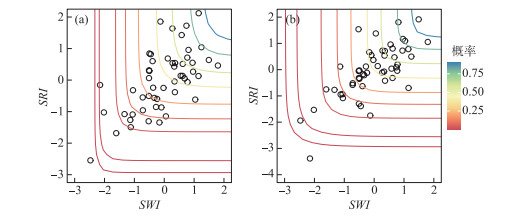
|
图 4 年尺度1964-2016年洞庭湖-流域系统水文干旱联合概率(a);洞庭湖-长江系统水文干旱联合概率(b) Fig.4 Annual scale isoline of the joint probability distribution of the concurrent droughts between Lake Dongting and its catchment(a); the joint probability between Lake Dongting and the Yangtze River(b) |
从季节分布来看,春、夏、秋和冬季洞庭湖-流域系统水文干旱的联合概率分别为9.52 %、7.64 %、7.98 % 和2.63 % (图 5和表 7),春季洞庭湖与流域同时发生水文干旱的概率均高于其它季节. 此外,1964-2016年间,春季洞庭湖-流域系统同时发生水文干旱事件7次,其中有2次出现在2003-2016年. 虽然洞庭湖与长江也同时发生水文干旱事件达7次,但全部出现在2003年以前,表明洞庭湖春季水文干旱与流域及长江径流变化均存在响应关系,但2003年后,流域径流对洞庭湖水文干旱的贡献增强. 对于洞庭湖-长江系统,其秋季水文干旱联合概率为15.38 % (图 6),是秋季洞庭湖-流域系统水文干旱联合概率的近2倍,远远高于其它季节. 研究时段内共识别出7次水文干旱事件,其中有5次发生在2003-2016年间,占总频次的一半以上,表明2003年以后秋季洞庭湖-长江系统同时发生水文干旱事件的频次明显增多. 总体而言,春季洞庭湖-流域系统水文干旱联合概率大于洞庭湖-长江系统,表明春季流域补给对洞庭湖水位具有主导作用. 夏、秋和冬季洞庭湖-长江系统水文干旱联合概率高于洞庭湖-流域系统,尤其在2003年之后秋季洞庭湖-长江系统水文干旱呈加剧态势.
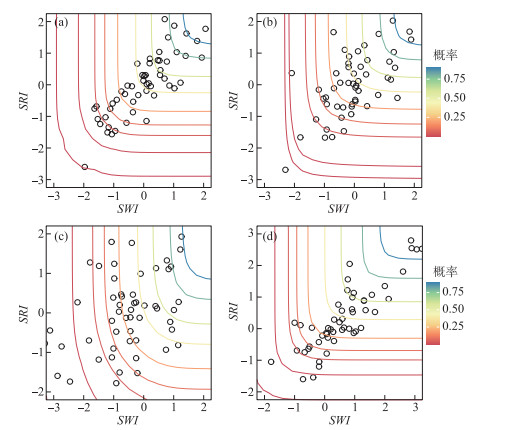
|
图 5 季节尺度1964-2016年洞庭湖-流域系统水文干旱联合概率 (a~d分别表示春、夏、秋、冬季) Fig.5 Seasonal joint probability of concurrent drought between Lake Dongting and its catchment from 1964 to 2016 (a-d illustrate probabilities in spring, summer, autumn and winter, respectively) |
| 表 7 1964-2016年洞庭湖-流域-长江系统水文干旱联合概率 Tab. 7 Joint probability of concurrent hydrological drought in the Lake Dongting-catchment-Yangtze River system during 1964-2016 |
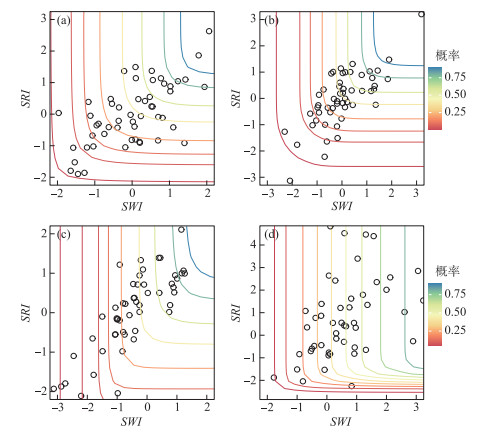
|
图 6 季节尺度上洞庭湖-长江系统水文干旱联合概率 (a~d分别表示春、夏、秋、冬季) Fig.6 Seasonal joint probability of concurrent drought between Lake Dongting and the Yangtze River from 1964 to 2016 (a-d illustrate probabilities in spring, summer, autumn and winter, respectively) |
洞庭湖水文干旱受流域和长江来水的共同影响,但其主导因素随时间发生变化[55]. 本文研究发现,在年和春季时间尺度上,洞庭湖-流域系统的水文干旱联合概率高于洞庭湖-长江系统,尤其是春季洞庭湖-流域系统的水文干旱联合概率达9.52 %,这表明春季洞庭湖水文干旱与流域水文干旱具有较好的同步性,流域入湖补给减少是春季洞庭湖水文干旱的主导因素. 孙占东等[34]通过对比不同季节长江与流域来水变化与典型干旱事件的对应关系,也认为湖泊春季干旱基本上是由洞庭湖流域来水偏少造成的;贺秋华等[56]研究发现流域“四水”与洞庭湖年均入湖径流量变化曲线呈同步增减趋势,且二者的相关系数为0.91,而长江“三口”年均分流入湖与洞庭湖入湖水量无明显相关性,说明洞庭湖年均入湖水量主要受流域来水影响,这与本文的研究结果较为一致. 洞庭湖流域来水变化的主要影响因素之一是降水的改变[57]. 由图 7所示,洞庭湖流域年际和季节性降水分配不均匀,季节性水文干旱与降水减少相对应,其中春季的每一次水文干旱事件均与降水量骤减相吻合. 比如,2011年春季流域降水量达到历史最低值,此时SRI也达到最低值-2.6(极端干旱). 吉红霞等[15]利用遥感影像和水文气象观测资料对2011年洞庭湖极端干旱事件的成因进行了分析,发现2011年洞庭湖流域4-5月降水量比多年平均偏少50 % 以上,降水减少是洞庭湖春季干旱发生的主导因素.
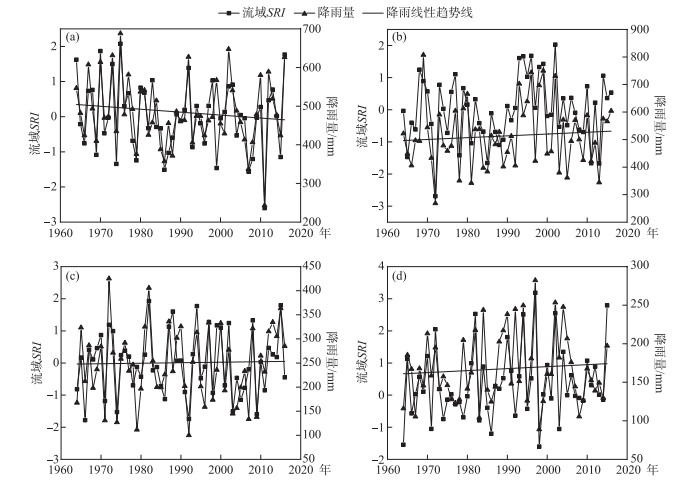
|
图 7 洞庭湖流域SRI与降水量季节分布 (a~d分别表示春、夏、秋、冬季) Fig.7 Seasonal distribution of SRI and precipitation in Lake Dongting catchment (a-d illustrate probabilities in spring, summer, autumn and winter, respectively) |
夏季、秋季和冬季的洞庭湖水文干旱主要受到长江来水变化的影响,尤其是秋季洞庭湖-长江系统同时发生水文干旱的概率达15.38 %. 特别是1964-2016年间秋季洞庭湖-长江系统同时发生的7次水文干旱事件有5次发生在2003年以后,这表明2003年后秋季洞庭湖-长江系统同时发生水文干旱事件的可能性增加,这主要由长江干流水利工程调度引起的长江来水变化导致的,以三峡水库蓄水最为典型[58-59]. 根据三峡水库优化调度方案,水库在9月15日后开始蓄水,此时长江中下游干流水位快速降低,对湖泊的顶托作用减弱[60]. Gao等[61]研究了三峡水库运行前后长江中下游的流量变化,发现三峡水库秋季蓄水是长江中下游河道流量显著减少的主要原因. 赖锡军等[62]研究发现,三峡水库秋季蓄水促使湖水加速流入长江,造成洞庭湖水位快速下降、低枯水位提前出现. 值得注意的是,秋季三峡水库开始蓄水,同时该时期洞庭湖流域降水也相对较少,流域来水对湖泊的补给减弱,两者的叠加效应极易引发湖泊极端水文干旱事件[63-64],如Ou等[65]研究表明,2006年秋季洞庭湖的极端干旱事件是由长江“三口”和流域“四水”来水锐减共同引起的,其中长江“三口”和流域“四水”来水量较同期多年平均值分别减少了74.7 % 和30.4 %.
除降水变化等气候因素和三峡蓄水对河湖水文要素的季节变化产生了显著影响外,其它人类活动的影响也不容忽视. 据湖南省水利发展统计公报显示[66],到2016年末,全省已建成各类水库14098座,总库容514亿m3,其中包括大型水库45座和中型水库359座,各类蓄水工程年末蓄水量242.5亿m3,水库的调度运行直接改变了径流的季节性分配[67]. 同时,洞庭湖流域也是我国植被变化最为显著的地区之一,该区域的森林覆盖率从1989年的36.7 % 上升到2016年的59.6 %,在一定程度上对流域径流过程产生影响[68-69]. 此外,洞庭湖平原作为我国重要的商品粮基地,农业耗水量在2016年为101.22亿m3,占各类用水消耗量的70 % 以上,耗水率也高达50 % 以上[70],尤其是农田用水量的峰值出现在秋季,与水库秋季蓄水、流域降水减少相叠加,更容易引发极端水文干旱事件[71-72]. 总的来说,人类活动对水资源的影响过程和机制是复杂的,在江-湖-河关系发生变化的背景下,一方面需要加强流域生态环境建设、优化水利工程调度方案,满足生产生活用水和生态用水需求[73],另一方面也应发展节水农业,提高农业生产用水效率. 而对定量评估不同人类活动对洞庭湖干旱的影响程度仍是目前研究的重点和难点,还需进一步通过定量模拟等手段开展深入研究.
4 结论本文基于标准化水位指数SWI和标准化径流指数SRI,通过Copula函数对1964-2016年洞庭湖-流域-长江系统水文干旱联合概率分布特征进行研究. 主要结论如下:
1) 年尺度上,洞庭湖流域发生水文干旱的概率最高,但洞庭湖及长江在2003年以后发生水文干旱的频次明显较多,所占比重较大. 季节尺度上,洞庭湖和长江2003年之后秋季水文干旱加剧,洞庭湖流域春季水文干旱概率远高于其它季节.
2) 年尺度上, 洞庭湖-流域系统水文干旱联合概率大于洞庭湖-长江系统,但2003年后洞庭湖-长江系统联合水文干旱频次明显多于洞庭湖-流域系统. 季节尺度上,洞庭湖-流域系统春季水文干旱联合概率最高,且两者同时发生水文干旱事件的次数最多;而洞庭湖-长江系统,其秋季水文干旱联合概率最大,并且一半以上的水文干旱事件发生在2003年以后.
3) 洞庭湖春季水文干旱与流域的水文干旱具有较好的同步性,流域入湖补给减少对洞庭湖春季水文干旱的影响更大. 而洞庭湖-长江系统秋季水文干旱自2003年以后更加极端和频发,这一方面受秋季降水减少和流域内人类活动的影响,造成流域径流对湖泊的补给减弱,另一方面三峡水库秋季蓄水使长江中下游干流水位降低,长江对湖泊顶托作用减弱也是重要原因之一.
| [1] |
Chen HP, Sun JQ. Changes in drought characteristics over China using the standardized precipitation evapotranspiration index. Journal of Climate, 2015, 28(13): 5430-5447. DOI:10.1175/jcli-d-14-00707.1 |
| [2] |
Wong G, van Lanen HAJ, Torfs PJJF. Probabilistic analysis of hydrological drought characteristics using meteorological drought. Hydrological Sciences Journal, 2013, 58(2): 253-270. DOI:10.1080/02626667.2012.753147 |
| [3] |
Ni SH, Gu Y, Peng YJ et al. Spatio-temporal pattern and evolution trend of drought disaster in China in recent seventy years. Journal of Natural Disasters, 2019, 28(6): 176-181. [倪深海, 顾颖, 彭岳津等. 近七十年中国干旱灾害时空格局及演变. 自然灾害学报, 2019, 28(6): 176-181. DOI:10.13577/j.jnd.2019.0619] |
| [4] |
Dai AG. Increasing drought under global warming in observations and models. Nature Climate Change, 2013, 3(1): 52-58. DOI:10.1038/nclimate1633 |
| [5] |
Song ZH, Xia J, She DX et al. Assessment of meteorological drought change in the 21st century based on CMIP6 multi-model ensemble projections over mainland China. Journal of Hydrology, 2021, 601: 126643. DOI:10.1016/j.jhydrol.2021.126643 |
| [6] |
Han LY, Zhang Q, Yao YB et al. Characteristics and origins of drought disasters in Southwest China in nearly 60 years. Acta Geographica Sinica, 2014, 69(5): 632-639. [韩兰英, 张强, 姚玉璧等. 近60年中国西南地区干旱灾害规律与成因. 地理学报, 2014, 69(5): 632-639.] |
| [7] |
Ma PL, Han LY, Zhang XD et al. Regional characteristics of drought in China under the background of climate warming. Journal of Desert Research, 2019, 39(6): 209-215. [马鹏里, 韩兰英, 张旭东等. 气候变暖背景下中国干旱变化的区域特征. 中国沙漠, 2019, 39(6): 209-215.] |
| [8] |
Zhang Q, Yao YB, Li YH et al. Progress and prospect on the study of causes and variation regularity of droughts in China. Acta Meteorologica Sinica, 2020, 78(3): 500-521. [张强, 姚玉璧, 李耀辉等. 中国干旱事件成因和变化规律的研究进展与展望. 气象学报, 2020, 78(3): 500-521.] |
| [9] |
Han LY, Zhang Q, Jia JY et al. Drought severity, frequency, duration and regional differences in China. Journal of Desert Research, 2019, 39(5): 1-10. [韩兰英, 张强, 贾建英等. 气候变暖背景下中国干旱强度、频次和持续时间及其南北差异性. 中国沙漠, 2019, 39(5): 1-10.] |
| [10] |
Zhang Q, Yao YB, Wang Y et al. Risk characteristics and control technology measures of drought disaster in Southern China. Acta Ecologica Sinica, 2017, 37(21): 7206-7218. [张强, 姚玉璧, 王莺等. 中国南方干旱灾害风险特征及其防控对策. 生态学报, 2017, 37(21): 7206-7218. DOI:10.5846/stxb201608111644] |
| [11] |
Sun CH, Yang S. Persistent severe drought in Southern China during winter-spring 2011: Large-scale circulation patterns and possible impacting factors. Journal of Geophysical Research-Atmospheres, 2012, 117(D10). DOI:10.1029/2012jd017500 |
| [12] |
Huang WH, Sui Y, Yang XG et al. Characteristics and adaptation of seasonal drought in Southern China under the background of climate change.Ⅲ. Spatiotemporal characteristics of seasonal drought in Southern China based on the percentage of precipitation anomalies. Chinese Journal of Applied Ecology, 2013, 24(2): 397-406. [黄晚华, 隋月, 杨晓光等. 气候变化背景下中国南方地区季节性干旱特征与适应.Ⅲ.基于降水量距平百分率的南方地区季节性干旱时空特征. 应用生态学报, 2013, 24(2): 397-406. DOI:10.13287/j.1001-9332.2013.0172] |
| [13] |
Wang LY, Yuan X. Two types of flash drought and their connections with seasonal drought. Advances in Atmospheric Sciences, 2018, 35(12): 1478-1490. DOI:10.1007/s00376-018-8047-0 |
| [14] |
Huang RH, Liu Y, Wang L et al. Analyses of the causes of severe drought occurring in southwest China from the fall of 2009 to the spring of 2010. Chinese Journal of Atmospheric Sciences, 2012, 36(3): 443-457. [黄荣辉, 刘永, 王林等. 2009年秋至2010年春我国西南地区严重干旱的成因分析. 大气科学, 2012, 36(3): 443-457.] |
| [15] |
Ji HX, Wu GP, Liu YB. Sharp change of lake levels during the two extreme droughts and its hydroclimatic processes in Lake Dongting, China. J Lake Sci, 2016, 28(1): 207-216. [吉红霞, 吴桂平, 刘元波. 极端干旱事件中洞庭湖水面变化过程及成因. 湖泊科学, 2016, 28(1): 207-216. DOI:10.18307/2016.0124] |
| [16] |
Mishra AK, Singh VP. A review of drought concepts. Journal of Hydrology, 2010, 391(1/2): 202-216. DOI:10.1016/j.jhydrol.2010.07.012 |
| [17] |
Wu ZY, Cheng DD, He H et al. Research progress of composite drought index. Water Resources Protection, 2021, 37(1): 36-45. [吴志勇, 程丹丹, 何海等. 综合干旱指数研究进展. 水资源保护, 2021, 37(1): 36-45.] |
| [18] |
Li LC, She DX, Zheng H et al. Elucidating diverse drought characteristics from two meteorological drought indices (SPI and SPEI) in China. Journal of Hydrometeorology, 2020, 21(7): 1513-1530. DOI:10.1175/jhm-d-19-0290.1 |
| [19] |
Wang F, Wang ZM, Yang HB et al. Comprehensive evaluation of hydrological drought and its relationships with meteorological drought in the Yellow River Basin, China. Journal of Hydrology, 2020, 584: 124751. DOI:10.1016/j.jhydrol.2020.124751 |
| [20] |
Li YP, Li YH. Advances in adaptability of meteorological drought indices in China. Journal of Arid Meteorology, 2017, 35(5): 709-723. [李忆平, 李耀辉. 气象干旱指数在中国的适应性研究进展. 干旱气象, 2017, 35(5): 709-723.] |
| [21] |
Mo XG, Hu S, Lu HJ et al. Drought trends over the terrestrial China in the 21st century in climate change scenarios with ensemble GCM projections. Journal of Natural Resources, 2018, 33(7): 1244-1256. [莫兴国, 胡实, 卢洪健等. GCM预测情景下中国21世纪干旱演变趋势分析. 自然资源学报, 2018, 33(7): 1244-1256. DOI:10.31497/zrzyxb.20170666] |
| [22] |
Li M, Hu WX, Wang GW et al. Drought risk in monsoon area of the Eastern China based on Copula function. Scientia Geographica Sinica, 2019, 39(3): 506-515. [李明, 胡炜霞, 王贵文等. 基于Copula函数的中国东部季风区干旱风险研究. 地理科学, 2019, 39(3): 506-515.] |
| [23] |
Milly PCD, Betancourt J, Falkenmark M et al. Climate change. Stationarity is dead: Whither water management?. Science, 2008, 319(5863): 573-574. DOI:10.1126/science.1151915 |
| [24] |
Wang YX, Li JZ, Feng P et al. A time-dependent drought index for non-stationary precipitation series. Water Resources Management, 2015, 29(15): 5631-5647. DOI:10.1007/s11269-015-1138-0 |
| [25] |
Wen QZ, Sun P, Zhang Q et al. A multi-scalar drought index for global warming: The non-stationary standardized precipitation evaporation index(NSPEI) and spatio-temporal patterns of future drought in China. Acta Geographica Sinica, 2020, 75(7): 1465-1482. [温庆志, 孙鹏, 张强等. 非平稳标准化降水蒸散指数构建及中国未来干旱时空格局. 地理学报, 2020, 75(7): 1465-1482. DOI:10.11821/dlxb202007010] |
| [26] |
Li M, Li JZ, Feng P et al. Construction of time-dependent drought index under changing environment and its application. Journal of Hydraulic Engineering, 2018, 49(11): 1386-1395. [李敏, 李建柱, 冯平等. 变化环境下时变标准化径流指数的构建与应用. 水利学报, 2018, 49(11): 1386-1395.] |
| [27] |
Guo SL, Yan BW, Xiao Y et al. Multivariate hydrological analysis and estimation. Journal of China Hydrology, 2008, 28(3): 1-7. [郭生练, 闫宝伟, 肖义等. Copula函数在多变量水文分析计算中的应用及研究进展. 水文, 2008, 28(3): 1-7.] |
| [28] |
Luo Y, Dong ZC, Guan XK et al. Flood risk analysis in the Taihu Basin during flood periods based on Copula function. J Lake Sci, 2020, 32(1): 223-235. [罗赟, 董增川, 管西柯等. 基于Copula函数的太湖流域汛期洪涝灾害危险性分析. 湖泊科学, 2020, 32(1): 223-235. DOI:10.18307/2020.0121] |
| [29] |
Wang XF, Zhang Y, Feng XM et al. Analysis and application of drought characteristics based on run theory and Copula function. Transactions of the Chinese Society of Agricultural Engineering, 2017, 33(10): 206-214. [王晓峰, 张园, 冯晓明等. 基于游程理论和Copula函数的干旱特征分析及应用. 农业工程学报, 2017, 33(10): 206-214. DOI:10.11975/j.issn.1002-6819.2017.10.027] |
| [30] |
Zhang Q, Li JF, Chen XH et al. Spatial variability of probability distribution of extreme precipitation in Xinjiang. Acta Geographica Sinica, 2011, 66(1): 3-12. [张强, 李剑锋, 陈晓宏等. 基于Copula函数的新疆极端降水概率时空变化特征. 地理学报, 2011, 66(1): 3-12.] |
| [31] |
Chen YQ, Sun P, Zhang Q et al. Copula-based analysis of hydrological drought frequency in Poyang Lake Basin. Journal of Natural Disasters, 2013, 22(1): 75-84. [陈永勤, 孙鹏, 张强等. 基于Copula的鄱阳湖流域水文干旱频率分析. 自然灾害学报, 2013, 22(1): 75-84. DOI:10.13577/j.jnd.2013.0111] |
| [32] |
Xu K, Yang DW, Xu XY et al. Copula based drought frequency analysis considering the spatio-temporal variability in Southwest China. Journal of Hydrology, 2015, 527: 630-640. DOI:10.1016/j.jhydrol.2015.05.030 |
| [33] |
Zhang D, Chen P, Zhang Q et al. Copula-based probability of concurrent hydrological drought in the Poyang lake-catchment-river system (China) from 1960 to 2013. Journal of Hydrology, 2017, 553: 773-784. DOI:10.1016/j.jhydrol.2017.08.046 |
| [34] |
Sun ZD, Huang Q, Jiang JH et al. Recent hydrological droughts in Lake Dongting and its association with the operation of Three Gorges reservoir. Resources and Environment in the Yangtze Basin, 2015, 24(2): 251-256. [孙占东, 黄群, 姜加虎等. 洞庭湖近年干旱与三峡蓄水影响分析. 长江流域资源与环境, 2015, 24(2): 251-256. DOI:10.11870/cjlyzyyhj201502010] |
| [35] |
Zhao GZ, Dong R, Wang HS et al. Hydrological variations and attribution analysis of Poyang Lake and Lake Dongting in the past 30 years. South-to-North Water Transfers and Water Science & Technology, 2020, 18(5): 74-83. [赵贵章, 董锐, 王赫生等. 近30年鄱阳湖与洞庭湖水文变化与归因. 南水北调与水利科技: 中英文, 2020, 18(5): 74-83.] |
| [36] |
Li JB, Wang KL, Yang Y et al. Characteristics and causes of agricultural drought disasters from 2000 to 2007 in the areas of Lake Dongting. Journal of Water Resources and Water Engineering, 2008, 19(6): 1-5. [李景保, 王克林, 杨燕等. 洞庭湖区2000年~2007年农业干旱灾害特点及成因分析. 水资源与水工程学报, 2008, 19(6): 1-5.] |
| [37] |
Sun ZD, Huang Q, Opp C et al. Impacts and implications of major changes caused by the Three Gorges Dam in the middle reaches of the Yangtze River, China. Water Resources Management, 2012, 26(12): 3367-3378. DOI:10.1007/s11269-012-0076-3 |
| [38] |
Guo LC, Su N, Zhu CY et al. How have the river discharges and sediment loads changed in the Changjiang River basin downstream of the Three Gorges Dam?. Journal of Hydrology, 2018, 560: 259-274. DOI:10.1016/j.jhydrol.2018.03.035 |
| [39] |
Cheng JX, Xu LG, Jiang JH et al. The research of runoff responses to climate change and human activities in the Lake Dongting catchment. Journal of Agro-Environment Science, 2016, 35(11): 2146-2153. [程俊翔, 徐力刚, 姜加虎等. 洞庭湖流域径流量对气候变化和人类活动的响应研究. 农业环境科学学报, 2016, 35(11): 2146-2153. DOI:10.11654/jaes.2016-0554] |
| [40] |
Xue LQ, Zhang JN, Liu XQ et al. Spatial and temporal patterns of droughts in Lake Dongting watershed based on improved meteorological drought composite index. Journal of Hohai University: Natural Sciences, 2014, 42(1): 1-6. [薛联青, 张竞楠, 刘晓群等. 基于改进的综合气象干旱指数的洞庭湖流域干旱时空特征. 河海大学学报: 自然科学版, 2014, 42(1): 1-6. DOI:10.3876/j.issn.1000-1980.2014.01.001] |
| [41] |
Dai X, He Z, Wan RR et al. Variation of seasonal water-level fluctuations in river-connected lakes in the middle reaches of Yangtze River in the recent three decades. Resources and Environment in the Yangtze Basin, 2017, 26(1): 118-125. [戴雪, 何征, 万荣荣等. 近35a长江中游大型通江湖泊季节性水情变化规律研究. 长江流域资源与环境, 2017, 26(1): 118-125. DOI:10.11870/cjlyzyyhj201701014] |
| [42] |
Sutanto SJ, Wetterhall F, van Lanen HAJ. Hydrological drought forecasts outperform meteorological drought forecasts. Environmental Research Letters, 2020, 15(8): 084010. DOI:10.1088/1748-9326/ab8b13 |
| [43] |
Mann HB. Nonparametric tests against trend. Econometrica, 1945, 13(3): 245-259. DOI:10.2307/1907187 |
| [44] |
Rashid MM, Beecham S. Development of a non-stationary Standardized Precipitation Index and its application to a South Australian climate. Science of the Total Environment, 2019, 657: 882-892. DOI:10.1016/j.scitotenv.2018.12.052 |
| [45] |
Song ZH, Xia J, She DX et al. The development of a Nonstationary Standardized Precipitation Index using climate covariates: A case study in the middle and lower reaches of Yangtze River Basin, China. Journal of Hydrology, 2020, 588: 125115. DOI:10.1016/j.jhydrol.2020.125115 |
| [46] |
Li YG, He JN, Li X. Hydrological and meteorological droughts in the red river basin of Yunnan Province based on SPEI and SDI indices. Progress in Geography, 2016, 35(6): 758-767. [李运刚, 何娇楠, 李雪. 基于SPEI和SDI指数的云南红河流域气象水文干旱演变分析. 地理科学进展, 2016, 35(6): 758-767.] |
| [47] |
Sklar M. Fonctions de Répartition À N Dimensions Et Leurs Marges. publ. inst. statist. univ. paris, 1960.
|
| [48] |
Zhang XM, Su XL, Zhang GX. Classifying drought in Heihe basin using SRI index and Copula function. Journal of Irrigation and Drainage, 2019, 38(5): 107-113. [张向明, 粟晓玲, 张更喜. 基于SRI与Copula函数的黑河流域水文干旱等级划分及特征分析. 灌溉排水学报, 2019, 38(5): 107-113.] |
| [49] |
Ravens B. An introduction to copulas. Technometrics, 2000, 42(3): 317. DOI:10.1080/00401706.2000.10486066 |
| [50] |
Genest C, Favre AC. Everything You always wanted to know about Copula modeling but were afraid to ask. Journal of Hydrologic Engineering, 2007, 12(4): 347-368. DOI:10.1061/(asce)1084-0699(2007)12:4(347) |
| [51] |
Salvadori G, de Michele C, Durante F. On the return period and design in a multivariate framework. Hydrology and Earth System Sciences, 2011, 15(11): 3293-3305. DOI:10.5194/hess-15-3293-2011 |
| [52] |
Kojadinovic I, Yan J. A non-parametric test of exchangeability for extreme-value and left-tail decreasing bivariate copulas. Scandinavian Journal of Statistics, 2012, 39(3): 480-496. DOI:10.1111/j.1467-9469.2011.00772.x |
| [53] |
Akaike H. A new look at the statistical model identification. IEEE Transactions on Automatic Control, 1974, 19(6): 716-723. DOI:10.1109/TAC.1974.1100705 |
| [54] |
Genest C, Nešlehová J, Quessy JF. Tests of symmetry for bivariate copulas. Annals of the Institute of Statistical Mathematics, 2012, 64(4): 811-834. DOI:10.1007/s10463-011-0337-6 |
| [55] |
Yuan YJ, Zhang C, Zeng GM et al. Quantitative assessment of the contribution of climate variability and human activity to streamflow alteration in Lake Dongting, China. Hydrological Processes, 2016, 30(12): 1929-1939. DOI:10.1002/hyp.10768 |
| [56] |
He QH, Yu DQ, Yu SC et al. Changes of water resources amount in Lake Dongting before and after the operation of the Three Gorges reservoir. Earth Science, 2021, 46(1): 293-307. [贺秋华, 余德清, 余姝辰等. 三峡水库运行前后洞庭湖水资源量变化. 地球科学, 2021, 46(1): 293-307.] |
| [57] |
Guo RF, Zhu YQ, Liu YB. A comparison study of precipitation in the Poyang and the Lake Dongting basins from 1960-2015. Scientific Reports, 2020, 10: 3381. DOI:10.1038/s41598-020-60243-8 |
| [58] |
Duan K, Xiao WH, Mei YD et al. An analysis of the impacts of large water projects on water resources utilization in the Lake Dongting region. Resources and Environment in the Yangtze Basin, 2012, 21(11): 1389-1394. [段凯, 肖伟华, 梅亚东等. 大型水利工程对洞庭湖区水资源开发利用的影响. 长江流域资源与环境, 2012, 21(11): 1389-1394.] |
| [59] |
Fang CM, Hu CH, Chen XJ. Impacts of Three Georges Reservoir's operation on outflow of the three outlets of Jingjiang River and Lake Dongting. Journal of Hydraulic Engineering, 2014, 45(1): 36-41. [方春明, 胡春宏, 陈绪坚. 三峡水库运用对荆江三口分流及洞庭湖的影响. 水利学报, 2014, 45(1): 36-41.] |
| [60] |
Lai XJ, Liang QH, Jiang JH et al. Impoundment effects of the three-gorges-dam on flow regimes in two China's largest freshwater lakes. Water Resources Management, 2014, 28(14): 5111-5124. DOI:10.1007/s11269-014-0797-6 |
| [61] |
Gao B, Yang DW, Yang HB. Impact of the Three Gorges Dam on flow regime in the middle and lower Yangtze River. Quaternary International, 2013, 304: 43-50. DOI:10.1016/j.quaint.2012.11.023 |
| [62] |
Lai XJ, Jiang JH, Huang Q. Pattern of impoundment effects and influencing mechanism of Three Gorges Project on water regime of Lake Dongting. J Lake Sci, 2012, 24(2): 178-184. [赖锡军, 姜加虎, 黄群. 三峡工程蓄水对洞庭湖水情的影响格局及其作用机制. 湖泊科学, 2012, 24(2): 178-184. DOI:10.18307/2012.0202] |
| [63] |
Dai ZJ, Du JZ, Li JF et al. Runoff characteristics of the Changjiang River during 2006: Effect of extreme drought and the impounding of the Three Gorges Dam. Geophysical Research Letters, 2008, 35(7). DOI:10.1029/2008gl033456 |
| [64] |
Zhang XY, Liu MX. Effects of climate change and human activities on water and sediment discharge in Xiangjiang basin. Research of Soil and Water Conservation, 2018, 25(1): 30-37. [张晓艳, 刘梅先. 气候变化及人为活动对湘江流域径流和输沙的影响. 水土保持研究, 2018, 25(1): 30-37.] |
| [65] |
Ou CM, Li JB, Zhang ZQ et al. Effects of the dispatch modes of the Three Gorges Reservoir on the water regimes in the Lake Dongting area in typical years. Journal of Geographical Sciences, 2012, 22(4): 594-608. DOI:10.1007/s11442-012-0949-7 |
| [66] |
Department of Water Resources of Hunan Province. 2016 Statistic Bulletin on Hunan Water Activities, 2017. [湖南省水利厅. 2016年湖南省水利发展统计公报, 2017. ]
|
| [67] |
Ye XC, Zhang Q, Liu J et al. Impacts of climate change and human activities on runoff of Poyang lake catchment. Journal of Glaciology and Geocryology, 2009, 31(5): 835-842. [叶许春, 张奇, 刘健等. 气候变化和人类活动对鄱阳湖流域径流变化的影响研究. 冰川冻土, 2009, 31(5): 835-842.] |
| [68] |
Ye XC, Zhang Q, Liu J et al. Distinguishing the relative impacts of climate change and human activities on variation of streamflow in the Poyang Lake catchment, China. Journal of Hydrology, 2013, 494: 83-95. DOI:10.1016/j.jhydrol.2013.04.036 |
| [69] |
Yu YW, Mei XF, Dai ZJ et al. Hydromorphological processes of Lake Dongting in China between 1951 and 2014. Journal of Hydrology, 2018, 562: 254-266. DOI:10.1016/j.jhydrol.2018.05.015 |
| [70] |
Department of Water Resources of Hunan Province. Water resources bulletin of Hunan Province in 2016, 2017. [湖南省水利厅. 2016年湖南省水资源公报, 2017. ]
|
| [71] |
Liang J, Yi YR, Li XD et al. Detecting changes in water level caused by climate, land cover and dam construction in interconnected river-lake systems. Science of the Total Environment, 2021, 788: 147692. DOI:10.1016/j.scitotenv.2021.147692 |
| [72] |
Zhao C, Zhou Y, Li XG et al. Assessment of cultivated land productivity and its spatial differentiation in Lake Dongting region: A case study of Yuanjiang City, Hunan Province. Sustainability, 2018, 10(10): 3616. DOI:10.3390/su10103616 |
| [73] |
Yang GS, Zhang Q, Wan RR et al. Lake hydrology, water quality and ecology impacts of altered river-lake interactions: Advances in research on the middle Yangtze River. Hydrology Research, 2016, 47(S1): 1-7. DOI:10.2166/nh.2016.003 |
 2022, Vol. 34
2022, Vol. 34 

